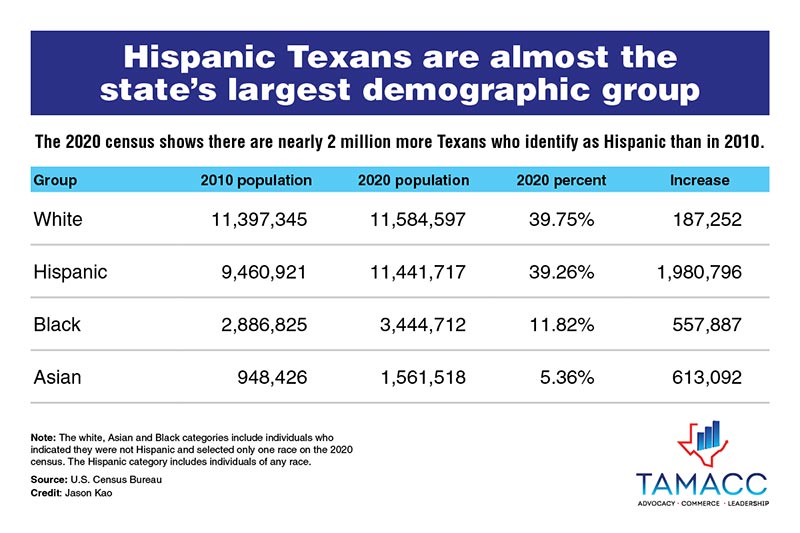Below are bullet points of information about the Hispanic population living in the United States. The source of information is from the US Census Bureau. We will add to or adjust these pages as new information comes available.
Important Note: According to the US Census Bureau’s own report Latinos had a net undercount of nearly 5% in the 2020 Census. The Black population had a net undercount of 3.3%, a slight increase from a 2.1% shortfall from 2010.
The report also reveals that the non-Latino white population had a net overcount in the 2020 census of 1.6% while Asians had a net overcount of 2.6%.
U.S. HISPANIC POPULATION
- The 2020 Census reveals the overall Hispanic population in the U.S. grew by 23%, to a total of 62.1 million. Over the past two decades 51% of the total U.S. population growth came from the Latino population.
- Three states saw their Hispanic populations increase by more than 1 million from 2010 to 2020. Texas (+2.0 million), California (+1.6 million) and Florida (+1.5 million) together accounted for 43% of the nation’s Hispanic population growth over the past decade.
- The share of U.S. Hispanics with college experience has increased since 2010. About 42% of U.S. Hispanic adults ages 25 and older had at least some college experience in 2019, up from 36% in 2010. More Hispanic women than Hispanic men have attended college, though the share with some college experience or more increased among both Hispanic women (38% to 45%) and Hispanic men (33% to 39%). Overall, the share of Hispanics with a bachelor’s degree or more education increased during this period, from 13% to 18%.
- The number of Latinos who identify as multiracial has also increased, from 3 million to more than 20 million. This is likely due in part to changes in the 2020 census form.
- Newborns are driving much of this Hispanic population growth, as immigration declined between 2010 and 2019. This is a reversal of historical trends.
- The share of Latinos in the U.S. who speak English proficiently is also growing. Some 72% of Latinos ages 5 and older spoke English proficiently as of 2019. Meanwhile, the share of Latinos who speak Spanish at home has declined (but the actual number has grown).
- People of Mexican origin made up almost 62% of the country’s overall Hispanic population as of 2019. The next largest group is those of Puerto Rican origin. The fastest population growth among U.S. Latinos has come among those with origins in Venezuela, Guatemala, and Honduras.
- Four out of five Latinos are U.S. citizens. As of 2019, 80% of Latinos living in the U.S. are citizens. The number includes people born in the U.S. and its territories, those born abroad to American parents and immigrants who have become naturalized citizens.
According to a US Census Bureau report, Latinos had a net undercount of nearly 5%. The Black population had a net undercount of 3.3%, a slight increase from a 2.1% shortfall a decade ago. American Indian and Alaska Natives living on reservations had a net undercount of 5.6%, up from 4.9% in the last census.
TEXAS HISPANIC POPULATION
Texas Has Been a Majority Minority State Since 2004
Texas Has Been a Majority Minority State for almost two decades. According to the US Census Bureau’s July 1, 2004, population estimates, Texas had a minority population of 11.3 million, comprising 50.2 percent of its total population of 22.5 million.
Latinos had a net undercount of nearly 5% in the 2020 Census
Important Note: According to the US Census Bureau’s own report Latinos had a net undercount of nearly 5% in the 2020 Census. The Black population had a net undercount of 3.3%, a slight increase from a 2.1% shortfall from 2010.
The report also reveals that the non-Latino white population had a net overcount in the 2020 census of 1.6% while Asians had a net overcount of 2.6%.
Texas Hispanics Are on Pace to Outnumber Whites in 2022
The below chart is based on the 2020 Census. Due to addition population growth and the undercount of Hispanics is the last census we are confident that Hispanics have already surpassed the number of non-Hispanic Whites in Texas.

There are 11.4 million Hispanics in Texas per the 2020 census. Texas ranks #2 in total Hispanic population among states in the U.S.
- The Texas Hispanic population increased by 21 percent since 2010.
- Mexicans are the largest ethnic group in Texas representing 83% (9.5 million) of the population. Other ethnic groups such as Salvadorans, Puerto Ricans, Hondurans, and Guatemalans have populations of over 100,000 each.
- Twenty-eight (28%) percent of Hispanics in Texas are foreign-born. This represents a 9% decrease in the foreign-born Hispanic population since 2010.
- The latest population projections show the projected growth rate for the Hispanic population from 2020 to 2050 to be 71%.
- According to the Bureau of Labor Statistics, the current labor force participation rate of Hispanics was among the highest at 66%, followed by Asians (64%), Whites (61.6%), and Black or African Americans (61.6%).
- Fifteen percent (15%) of Hispanics 25 years and older have earned a bachelor’s degree or higher, representing a 36% increase since 2010.
- Harris, Bexar, Dallas, Hidalgo, and El Paso Counties have the largest Hispanic populations comprising 5.7 million of all Hispanics in Texas.
- Of the major cities in Texas, San Antonio has the highest percent of Hispanic population (64%).
- In 2020, Starr (98%), Webb (95%), Maverick (95%), Zapata (94%), and Zavala (92%) counties had the highest share of Hispanics.
- Counties to the north and east of the state experienced the greatest percent increase in Hispanic population since 2010.
- From 2010 to 2020, Oldham, San Jacinto, and Liberty counties experienced the greatest percent increase in Hispanic population, while Loving, Concho, and King counties experienced the greatest percent decrease.
Sources: Texas Demographic Center, Vintage 2018 Population Projections. U.S. Census Bureau, American Community Survey (ACS) 5-Year Estimates, 2006-2010, 2015-2019; 2010 & 2020 Decennial Census P.L. 94-171 Redistricting Data. U.S. Bureau of Labor Statistics, Current Population Survey and Current Employment Statistics, 2021.





















